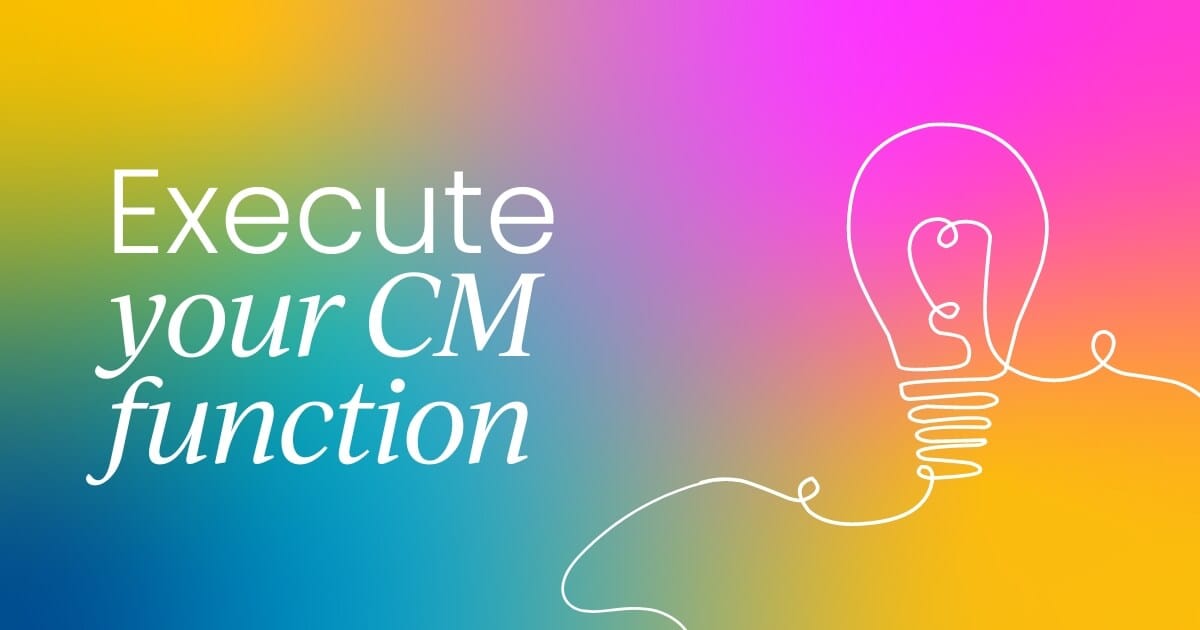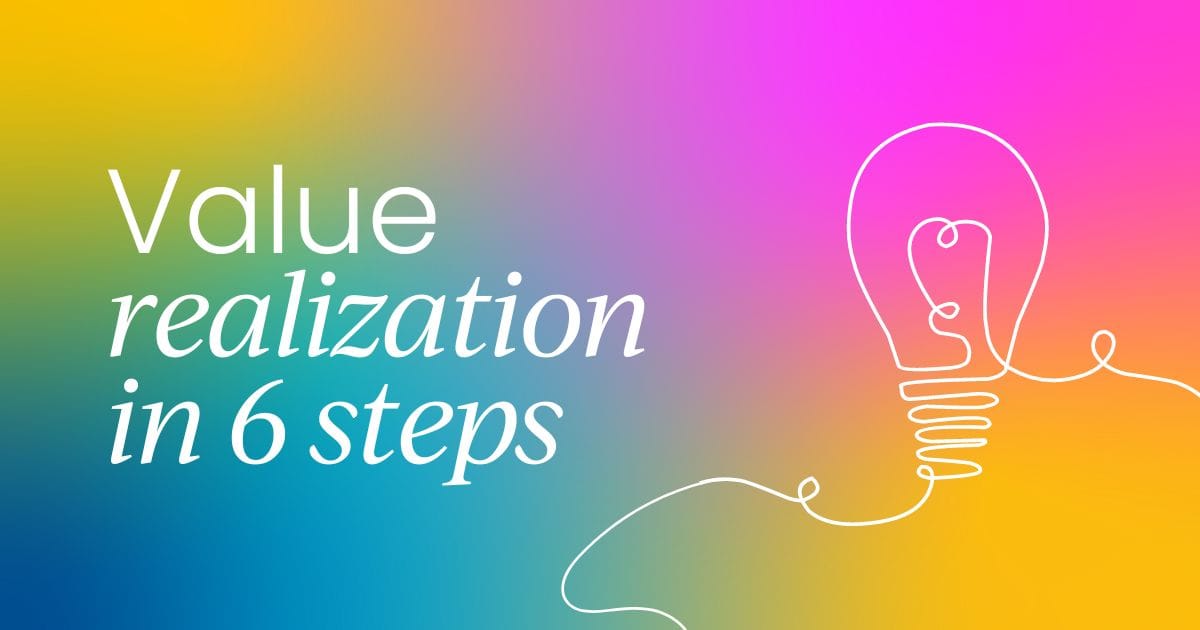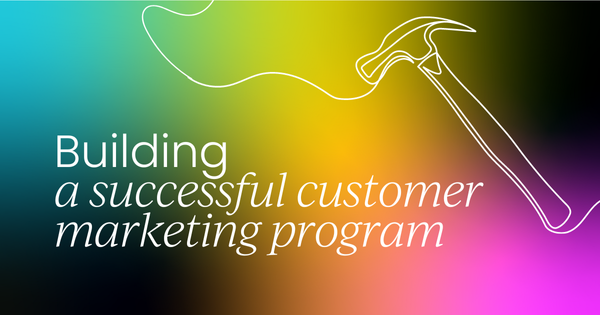This article comes from Gillian Farquhar’s insightful talk at our Customer Marketing Summit in Boston 2024, check out the full presentation.
Building a successful customer marketing program is no small feat.
I'm Gillian Farquhar, and I've had the privilege of learning what works—and what doesn’t—when it comes to customer marketing.
Now, as I take on the challenge of establishing customer marketing at Infor, I’ve realized that each build is unique. In this article, I’ll share my journey, the lessons I’ve learned, and the strategies I’m using to create a high-impact, cost-efficient customer marketing program that drives value across the business.
My philosophy for building a customer marketing program
None of what I’m about to share is absolute; it's just my perspective. I think of advocacy as an outcome, not a title. In fact, I don’t like the word "advocate" at all. I don’t like being called an advocate, nor do I want to be thought of as one. To me, the term needs a rebrand.
When people ask me, "Well, what do you call them, then?" I simply say, "I call them customers." I’ve been saying this for about 10 years now, and I still stand by it.
As a customer myself, I think about how I want to be treated by the brands and products I care about. Being labeled as an advocate doesn’t resonate with me. I don’t see the value in it, and that bias is reflected in most of my work.
Now that I’m in a new organization, I’m constantly educating others—and being educated myself—on what customer marketing is and the value it brings.
Living in the post-sale
Recently, I had to present my perspective to the executive leadership team, which was a little nerve-wracking. My pitch was simple: "Customer marketing lives in the post-sale." That’s where we pick up the baton. But our work doesn’t just stop there—we influence demand generation, the sales funnel, and the pipeline.
Now, I’m in a company that’s heavily focused on demand generation and net new business, which I completely understand. But as I often say, you have to pick your battles. Right now, I’m figuring out where customer marketing fits into that framework.
While my team operates in the post-sale, we influence everything that comes before and after it. If we’re doing our job right, demand gen should get easier, and the sales funnel should open up.
Building and nurturing communities
One of my core beliefs is that our primary remit is to find, build, or nurture communities of users. These users are then activated and reintroduced into the market in a way that benefits everyone, including the demand gen team. They're not just reference points; they are an integral part of the ecosystem.
And let me be clear: I don’t just mean end users. Partners are also a part of this. I don’t differentiate between them because, in my view, they’re both customers. These groups—users and partners alike—are our best salespeople, our most influential product experts, and our most resourceful problem solvers.
They’re the best moderators in community forums, which means you don’t need to hire an army of community managers. If you empower your top users with the tools they need, they will scale your efforts for you.
Customer marketing’s role in a revenue-driven world
What I’m talking about here might sound like customer marketing 101, but it’s not always obvious in organizations that are hyper-focused on revenue generation in a formulaic way. It’s been a shift for the company I’m now building within.
My goal is to prove that customer marketing adds value across the entire organization, even though it’s often seen as a secondary or supporting function. In reality, it plays a vital role in driving sustainable growth and long-term success.

Lessons learned in my first 90 days at Infor
Everything I thought I was going to accomplish in my first 90 days at Infor is not what I’ve ended up doing. One of the main reasons for that is customer marketing—at least in the way I define it or see its value—isn’t well understood in the organization.
A large part of my day is spent on calls, educating colleagues, and helping them understand the vision I’m trying to build. I'm often in meetings where I’m not directly contributing to my actual remit, but I’m building relationships that’ll be valuable later. This is a huge part of leading by influence rather than by organizational authority, especially when you don’t have a team.
Rediscovering humility
One thing that has been front and center for me in this new role is humility. I’ve rediscovered it in a way I wasn’t expecting.
Coming into Infor, I thought I knew how to build a customer marketing function. After all, I had built one of the best in the business at Qlik—or at least, that’s what I told myself. But in reality, that doesn’t matter. No one really cares about what you’ve done before. It’s a humbling realization, but one that I now live with every day.
In a way, it’s been great not having a team right now, because I’m relearning things I’d forgotten—like what tools I really need and how to make smaller, strategic investments without setting off alarms in the finance department. I’m approaching the build differently, under the radar, figuring out how to get things done before scaling.
Transformation is hard
This might sound obvious, but transformation is hard—really hard. Especially in a company like Infor, which has been around for 25 years and has over 18,000 employees.
There’s a lot of history and processes that came before me, and they’re all valuable. In comparison, my earlier build at Qlik seems almost easy now. Back then, I had no fear—everything I did was exciting, and I wasn’t worried about what could go wrong.
Here, it’s different. There are more eyes on me because the company has invested in leadership for this function. That means expectations are high, and people are watching to see how things unfold. It’s a very different dynamic, but it's also a reminder of where I am and the stakes of this new role.
I wanted to share this with you to give a sense of where I’m coming from and the journey I’m on right now. It’s challenging, but it’s also rewarding in ways I hadn’t expected.

Challenges and opportunities
My earlier build at Qlik was quite easy compared to what I’m facing now. It’s like building on top of ancient Troy: every time I dig, I find something buried that needs to be uncovered, understood, or navigated like a trap.
And I say this with love because I now realize that what I lacked in my career before was humility. I needed this experience to see what I didn’t know, and it has been incredibly humbling.
This new role has kept me grounded, and I’ve learned so much already. I’m genuinely enjoying the process and am eager to learn more from others. I’m not sure I can teach much at the moment, but I could definitely talk your ear off about what I’ve been through so far.
Starting from scratch
To put it simply, this is a ground-zero moment for me in terms of building customer marketing at Infor. The company has very little in the way of what I would define as customer marketing. There’s no deeply embedded post-sale experience in place yet—but we’ll get there.
The bright spot is that Infor does have a really robust reference function. In fact, a past colleague of mine, who’s here today, used to run that team, and it's a large and well-established group.
However, it sits within customer success, not under the umbrella of customer marketing.
What I’ve found fascinating is that there are thousands of highly engaged customers out there who aren’t yet part of what I call the “Infor Nation.” Yes, I used the same naming playbook at Qlik, calling it “Qlik Nation.” It’s a simple concept, but it works.
Tapping into the untapped
Before I took this role, I asked myself, "Does this company have what I need to be successful?" I didn’t have a clear answer until I started digging into the business.
I’ve discovered that there are thousands of Infor customers who are self-organizing into user groups independently of the company. Imagine having that kind of customer engagement and not yet being connected to it!
But I believe we can bring that community into the fold in a more organic way, and when we do, it’s going to be incredibly powerful.
Not everyone at Infor believes me when I say this. People often respond with, “We need a case study first.” But trust me—it’s going to work.
The content paradox
One of the strangest opportunities I’ve come across is what I call a “content paradox.” There’s an abundance of customer content available, yet people still say we don’t have enough references or stories.
It’s like being surrounded by water and still feeling thirsty. There’s no shortage of content, but somehow, there’s a gap in how it’s being used or activated. This is a massive opportunity to streamline and leverage the content we already have to build stronger stories and references.
A cloud-first future
Another big focus at Infor is cloud-based solutions. We’re transitioning more toward a B2B SaaS model, which is something I understand well from my past experiences.
I’ve worked extensively on standing up account-based marketing (ABM), customer experience, and traditional customer marketing programs, including executive councils and reference programs. So, I'm excited that the company is moving in this direction, and I feel well-equipped to help build that foundation.
There’s a lot of work ahead, but the opportunities are enormous, and I’m thrilled to be a part of this transformation.
Five dimensions of principle-based management
These five dimensions of PBM have completely shifted how I approach building the customer marketing function. They may seem obvious, but they’ve been a game-changer in prioritizing what to focus on first.
1. Vision
The first dimension focuses on understanding the company’s vision. Infor has a lot of legacy customers—many using on-prem solutions—but the company’s vision is tied to moving toward a cloud-first, eventually cloud-only, model. That’s a big shift when two-thirds of your customers are still using the old model.
I needed to understand this vision at a high level to make the right decisions for customer marketing. It didn’t matter if I didn’t know all the product names yet; what mattered was understanding where the business was headed.
I also want to emphasize the importance of coaching. Throughout my career, I’ve had great coaches—both paid and unpaid—and they’ve helped me get to where I am today. I’ve been fortunate to be mentored by women who’ve climbed the ranks in marketing and tech, and their guidance has been crucial in helping me navigate this new role.
It’s been all about understanding the broader business goals and aligning my decisions with that vision.
2. Virtues and talents
With no open RECs for a team of 10, I’ve had to be strategic about hiring. In the next 60 days, I’ll be making two critical hires—people who have specific skills that are essential to our success this year.
I’m also thinking about what I already have in place. I’ve inherited some talented teammates, so it’s about identifying what additional skills I need to complement the team and fill any gaps.
3. Knowledge
Data is essential, and coming from a data-driven company like Qlik, I know how powerful it can be. But here at Infor, if I ask about Net Revenue Retention (NRR) for a particular product, it’s not an easy answer.
I need a source of truth for customer data, and with hundreds of products at this company, that’s no small task. I need someone who can help me get a handle on the data—someone who understands how our customers use our technology.
4. Comparative advantage
Comparative advantage is all about understanding your strengths and weaknesses. It sounds simple, but it’s vital.
I’ve had to be honest with myself about what I’m not good at. Operations, for example, is not my strength. I’m great with vision—I can quickly picture what I want to build—but the operational side isn’t my comparative advantage.
Where I excel is in creativity and customer centricity. Knowing this, I’m not afraid to bring in people who are better at operations, so they can fill in the gaps and help me build something more complete. It’s about putting together a team where everyone is playing to their strengths.
5. Motivation
The last dimension, which is very personal, is about staying motivated. What drives me is the desire to add value to the organization.
My goal is to make sure every decision I make is aligned with this, whether it’s about hiring the right talent, choosing the right tools, or determining how to best use the resources I have. This mindset informs everything from my budget investments to the culture I’m working to build within the team.
This framework has helped me approach things differently and forced me to rethink how I build this customer marketing function at Infor. It’s been an eye-opener, and while it’s early days, I feel confident that these principles will help guide me through the challenges ahead.
Why customer marketing matters
I think we all know why customer marketing matters, but it’s worth reiterating. Customer marketing is one of the lowest-cost functions, yet it brings incredibly high value when done right.
The impact is rapid, and you can scale it up or down quickly with minimal investment. If someone ever tells you that customer marketing is too expensive, they simply don’t understand it.
In fact, I’ve done a lot of ROI work around this, and I can show you—though not today—all the data that proves the value of customer marketing. It’s not just about post-sale; customer marketing influences net-new acquisition as well.
Even in an organization like mine, which is heavily focused on net-new business, customer marketing still plays a critical role in affecting every stage of the funnel.


 11 min read
11 min read
 Follow us on LinkedIn
Follow us on LinkedIn





